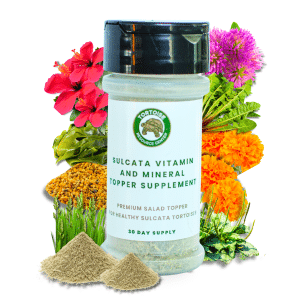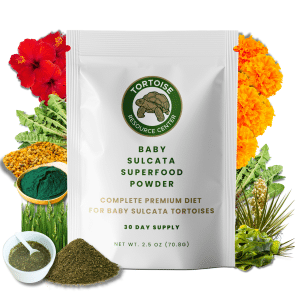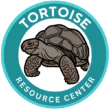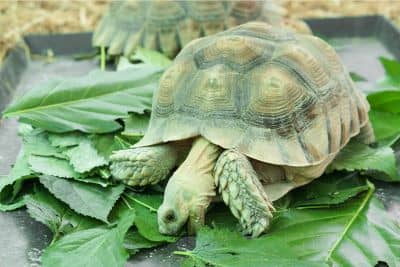How Much Protein Do Baby Sulcatas Need? Did you know that tortoises have really different protein requirements, depending on not only their species, but their age? If you’ve been researching baby sulcata care, you’ve probably encountered conflicting information about their protein requirements.
Some sources claim all tortoises need extremely low-protein diets, while others suggest higher protein for growing babies. This confusion has led many keepers to make critical mistakes that can impact their tortoise’s development for life.
Here’s the reality: baby sulcatas have dramatically different protein needs than adults, and getting this wrong can cause serious problems. Feed too little protein, and you’ll see stunted growth, weak shell development, and poor muscle tone. Feed too much or the wrong type, and you risk kidney damage, shell deformities, and metabolic disorders.
That’s why it is absolutely essential to feed your baby sulcata a diet designed specifically for growing grassland tortoises.
The challenge is that most protein guidelines for tortoises are written for adults. Adult sulcatas thrive on very low-protein diets (4-8% protein), but applying these same recommendations to rapidly growing babies is like putting a marathon runner on a toddler’s diet—it simply won’t support their development needs.
This guide will give you the specific, science-based information you need to provide the right amount and type of protein for your baby sulcata at every stage of development.

Why Baby Sulcatas Need More Protein Than Adults
Baby sulcatas aren’t just smaller versions of adult tortoises—they’re growing machines with completely different metabolic requirements. During their first year, a healthy baby sulcata can increase its body weight by 500% or more. This isn’t just getting bigger; they’re building muscle tissue, developing organs, strengthening bones, and forming the keratin structures in their shells.
All of this development requires amino acids—the building blocks of protein. While adult sulcatas focus on maintaining existing body mass, babies are actively constructing new tissues every single day. This process demands significantly higher protein intake relative to their body size.
Adult sulcatas have fully developed digestive systems that can extract maximum nutrition from low-protein, high-fiber plant matter. Baby sulcatas are still developing these capabilities, so they need more concentrated nutrition, including higher protein levels, to support their rapid growth.
Optimal Protein Levels by Age
Hatchlings (0-6 months): Target protein level: 14-18% of total diet At this stage, your baby sulcata is in its most rapid growth phase. The higher protein requirement supports critical organ development, shell formation, and initial muscle development. Try our Baby Sulcata Superfood Powder on Amazon today for your growing sulcata.
Young Juveniles (6-12 months): Target protein level: 12-15% of total diet Growth rates begin to stabilize slightly, but protein needs remain high to support continued development and bone strengthening.
Older Juveniles (12-18 months): Target protein level: 10-12% of total diet As growth slows and digestive systems mature, protein requirements begin transitioning toward adult levels.
Transition Phase (18-24 months): Target protein level: 8-10% of total diet During this period, gradually reduce protein levels while monitoring growth and development closely.
Adults (24+ months): Target protein level: 4-8% of total diet Mature sulcatas require much lower protein levels to maintain health and prevent kidney stress.

Plant-Based Protein Sources for Baby Sulcatas
Unlike mammals or birds, baby sulcatas should get their protein exclusively from plant sources. Their digestive systems aren’t designed to process animal proteins efficiently, and excessive animal protein can cause serious kidney problems.
High-Protein Grasses and Hays:
- Alfalfa (young plants): 18-22% protein
- Clover (fresh): 15-18% protein
- Timothy grass (young shoots): 10-12% protein
- Bermuda grass (tender tips): 8-12% protein
The key is offering these plants when they’re young and tender, as protein content decreases significantly as plants mature.
Protein-Rich Vegetables:
- Dandelion greens: 2.7% protein (but high in other nutrients)
- Mustard greens: 2.9% protein
- Collard greens: 2.5% protein
- Turnip greens: 1.5% protein
While these percentages seem low, remember that vegetables should make up a significant portion of the diet, so their protein contribution adds up.
Legume Plants (Use Sparingly):
- Fresh pea plants (including pods): 5-7% protein
- Fresh bean plants: 4-6% protein
- Fresh lentil plants: 6-8% protein
These should only be offered occasionally, as too much can upset the calcium-to-phosphorus balance in the diet.
Commercial Protein Sources
High-quality commercial tortoise foods can help ensure consistent protein intake, especially when fresh high-protein plants aren’t available. However, choosing the right commercial food is crucial.
What to Look For:
- Protein content between 12-18% for growing tortoises
- Plant-based protein sources (avoid animal meal or byproducts)
- High-quality ingredients with timothy hay or alfalfa as primary components
- No artificial colors, preservatives, or fillers
How to Use Commercial Foods: Commercial foods should supplement, not replace, fresh plant matter. Use them to fill nutritional gaps and ensure consistent protein intake, especially during seasons when fresh options are limited.

Products like our Baby Sulcata Superfood Powder are formulated specifically to provide the right protein levels and amino acid profiles for growing sulcatas without the risks associated with excessive animal protein or poor-quality fillers.
Protein Quality vs. Quantity
Not all proteins are created equal. Baby sulcatas need complete proteins that contain all essential amino acids in the right proportions. Plant proteins can provide this, but you need variety to ensure complete amino acid profiles.
Essential Amino Acids for Sulcatas:
- Lysine (critical for shell and bone development)
- Methionine (supports healthy shell keratin)
- Tryptophan (important for growth and stress resistance)
- Threonine (supports immune function)
- Leucine, isoleucine, and valine (muscle development)
Creating Complete Protein Profiles: Combine different plant protein sources throughout the week:
- Grasses provide some amino acids
- Legumes provide others
- Dark leafy greens contribute additional amino acids
- Quality supplements can fill any remaining gaps
Signs of Protein Deficiency in Baby Sulcatas
Stunted Growth: If your baby sulcata isn’t growing at expected rates despite adequate food intake, protein deficiency could be the culprit. Healthy babies should show consistent size increases week to week.
Weak Shell Development: Soft shell areas, irregular growth patterns, or shells that seem thin or flexible may indicate insufficient protein for proper keratin formation.
Poor Muscle Tone: Baby sulcatas with protein deficiency often appear weak, have difficulty supporting their own weight, or show reluctance to move around normally.
Delayed Development: Missing developmental milestones, slow response to stimuli, or general lethargy can indicate inadequate protein intake.
Increased Susceptibility to Illness: Protein is essential for immune system function. Deficient tortoises may get sick more frequently or take longer to recover from illness.
Are You Starving Your Tortoise?
Save 10% on premium tortoise food and supplements from Tortoise Resource Center on Amazon now using code BUYNOWGET10

Sulcata Vitamin & Mineral Topper Supplement
30-Day Supply | 2 oz (56 g)
$24.99

Baby Sulcata Tortoise Superfood Powder
30-Day Supply | 2.5 oz (70.8 g) Bag
$24.99
Signs of Protein Excess
Rapid, Abnormal Growth: Excessive protein can cause unnaturally fast growth that leads to shell deformities and developmental problems. Growth should be steady but not explosive.
Kidney Problems: Signs include decreased appetite, lethargy, swelling around the eyes or limbs, and changes in urination patterns. These are serious symptoms requiring immediate veterinary attention.
Shell Pyramiding: While multiple factors contribute to pyramiding, excessive protein combined with other dietary imbalances can worsen this condition.
Digestive Issues: Too much protein can cause diarrhea, abnormal waste consistency, or digestive upset in young tortoises.
Balancing Protein with Other Nutrients
Protein doesn’t exist in isolation—it must be balanced with other nutrients for optimal health.
Calcium-to-Phosphorus Ratios: Many high-protein plants are also high in phosphorus, which can interfere with calcium absorption. Maintain a 2:1 to 3:1 calcium-to-phosphorus ratio overall.
Fiber Requirements: Even baby sulcatas need adequate fiber for proper digestive function. Don’t focus so heavily on protein that you neglect fiber-rich foods like grasses and hay.
Vitamin and Mineral Balance: Protein metabolism requires specific vitamins and minerals. B vitamins, zinc, and magnesium are particularly important for proper protein utilization. Our Vitamin and Mineral Topper includes these essential cofactors to help ensure your baby sulcata can properly utilize dietary protein.
Seasonal Protein Adjustments
Baby sulcata protein needs can vary based on environmental conditions and seasonal factors.
Spring and Summer: During active growing seasons when temperatures are optimal, protein requirements may be at their highest. Fresh, young plant growth is also most available during these periods.
Fall and Winter: If you allow natural temperature fluctuations, your baby sulcata’s metabolism may slow, reducing protein requirements. However, maintain adequate protein to support continued development.
Temperature-Dependent Metabolism: Cooler temperatures slow protein metabolism, while warmer temperatures increase it. Adjust protein intake based on your enclosure’s temperature patterns.
Age-Based Feeding Strategies
0-6 Months: High-Protein Foundation Focus on protein-rich young grasses, quality commercial foods, and nutrient-dense vegetables. Feed daily with careful attention to growth rates.
6-12 Months: Sustained Growth Support Continue high protein intake while introducing more variety. Monitor for signs of too-rapid growth and adjust if necessary.
12-18 Months: Gradual Transition Begin slowly reducing protein levels while maintaining growth monitoring. This is a critical transition period requiring careful observation.
18+ Months: Adult Preparation Continue gradual protein reduction while ensuring the tortoise maintains good body condition and growth rates.
Common Protein Mistakes
Mistake #1: Using Adult Guidelines Too Early Many keepers apply adult low-protein recommendations to babies, resulting in stunted growth and developmental problems.
Mistake #2: Fear of All Protein Some keepers become so afraid of protein that they severely restrict it, causing more problems than they prevent.
Mistake #3: Inconsistent Protein Levels Wild fluctuations in protein intake can stress young tortoises and lead to irregular growth patterns.
Mistake #4: Wrong Protein Sources Using animal-based proteins or low-quality plant proteins that don’t provide complete amino acid profiles.
Mistake #5: Ignoring Individual Needs Not all baby sulcatas grow at the same rate or have identical protein requirements. Some adjustment based on individual development is necessary.
Monitoring Protein Adequacy
Weekly Growth Measurements: Track weight and shell measurements weekly for babies under 6 months. Consistent growth indicates adequate protein intake.
Monthly Development Assessment: Look for proper muscle development, shell hardening, and overall body condition. Healthy tortoises should feel solid and well-proportioned.
Annual Veterinary Check-ups: Have your baby sulcata examined by a reptile veterinarian at least annually. Blood work can reveal protein metabolism issues before they become visible.
Behavioral Observations: Well-nourished tortoises are active, alert, and engage normally with their environment. Changes in behavior can indicate nutritional problems.
Creating a Protein-Balanced Diet Plan
Daily Protein Distribution: Rather than providing all protein in one meal, distribute it throughout the day’s food offerings. This supports better digestion and utilization.
Weekly Variety Planning: Plan weekly menus that include different protein sources to ensure complete amino acid profiles. Don’t rely on the same foods every day.
Seasonal Menu Adjustments: Adjust protein sources based on seasonal availability while maintaining consistent protein levels overall.
Emergency Protein Sources: Always have backup high-protein foods available: dried alfalfa, quality commercial foods, and reliable supplements that can maintain protein intake when fresh options aren’t available.
Transitioning to Adult Protein Levels
When to Begin Transition: Most sulcatas can begin transitioning to lower protein levels around 18 months, but this varies based on individual development and growth rates.
Gradual Reduction Strategy: Reduce protein levels by 1-2% every few months while monitoring growth and body condition. Sudden changes can stress the tortoise’s system.
Monitoring During Transition: Watch for signs that protein reduction is happening too quickly: slowed growth, lethargy, or changes in shell development quality.
Individual Adjustment: Some tortoises may need higher protein levels longer than others. Base decisions on your specific tortoise’s development rather than rigid timelines.
Long-Term Health Implications
The protein foundation you provide during the first 18-24 months of life will impact your sulcata’s health for decades. Baby sulcatas that receive appropriate protein during this critical period develop:
- Strong, properly-formed shells with good keratin structure
- Robust muscle development that supports lifelong mobility
- Healthy organ development, particularly kidneys and liver
- Strong immune systems that resist disease
- Proper bone density that prevents fractures and deformities
Conversely, protein deficiency during this period can cause problems that persist throughout the tortoise’s life, including weak shells, poor muscle tone, increased disease susceptibility, and reduced lifespan.

Creating Your Protein Management Plan
Every baby sulcata’s protein needs will vary slightly based on genetics, environment, and individual development rates. Your protein management plan should include:
Regular Assessment: Weekly monitoring of growth rates, body condition, and development milestones to ensure protein intake is appropriate.
Flexible Adjustment: Willingness to adjust protein levels based on your tortoise’s individual response rather than following rigid guidelines.
Quality Focus: Emphasis on high-quality, plant-based protein sources that provide complete amino acid profiles.
Professional Support: Regular veterinary check-ups to ensure protein metabolism is healthy and to catch potential problems early.
Long-Term Perspective: Understanding that the protein choices you make now will influence your tortoise’s health for the next 50+ years.
Your baby sulcata is depending on you to provide the protein foundation for healthy development and a long life. With careful attention to protein quality, quantity, and timing, you can ensure your tortoise gets exactly what it needs to develop into the strong, healthy adult it’s meant to become. The investment in proper protein nutrition during these critical months will pay dividends for decades to come. Want to save 10% on our products designed for sulcatas? Sign up for our bonus pack today!


